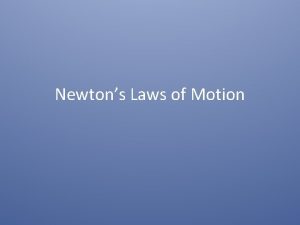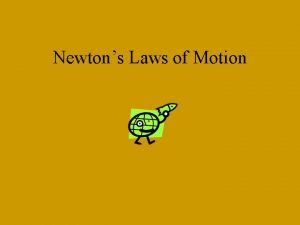Newtons Laws of Motion Physics Ms Jeffrey Newtons






- Slides: 6

Newton’s Laws of Motion Physics- Ms. Jeffrey

Newton’s 1 st Law of Motion • An object at rest tends to stay at rest, while an object in motion will stay in motion unless acted upon by an unbalanced force • Also known as the Law of Inertia • All objects resist changes in their motion

Inertia § Inertia- The resistance an object has to a change in its’ motion § Forces are not needed to keep an object in motion. § It is the presence of a force that causes objects to start, or stop moving. § All objects experience inertia § Some more than others § Mass is dependent upon inertia! § The more inertia an object has, the more mass it has § More massive objects have greater tendencies to resist change

Newton’s 2 nd Law of Motion • The acceleration of an object is • • • dependent upon two variables - the net force acting upon the object and the mass of the object. Also known as the Law of force and acceleration. Net force- Vector sum of ALL forces a=Fnet/ m The direction of the net force is in the same direction as the acceleration What is the unit for Force?

Newton’s 3 rd Law of Motion • For every action, there is an equal and opposite reaction. • Also known as the Law of action/reaction • The size of the force on the first object equals the size of the force on the second object. • The direction of the force on the first object is opposite to the direction of the force on the second object. • Forces ALWAYS come in pairs.

Which Law is presented? • A seatbelt stops you from hitting the windshield after slamming on your breaks. • Your feet push down on the floor, while the floor pushes up on you. • It is easier to push a bike, than it is to push a car at the same speed. • A soccer ball will not move until a player kicks it. • A magician pulls a tablecloth out from underneath dishes on a table. • A tennis racket interacting with a tennis ball upon contact. • It is easier to push an empty shopping cart, then it is to push a full one.











